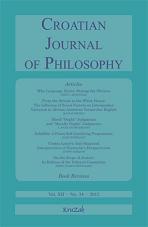From the Streets to the White House: The Infl uence of Social Factors on Interspeaker Variation in African-American Vernacular English
From the Streets to the White House: The Infl uence of Social Factors on Interspeaker Variation in African-American Vernacular English
Author(s): Matjaž EzgetaSubject(s): Philosophy
Published by: KruZak
Keywords: sociolinguistics; spoken language; African-American Vernacular English; grammatical features; social factors.
Summary/Abstract: Most linguists have defi ned African-American Vernacular English (AAVE) as a regular and systematic form of vernacular language which contains distinctive grammatical and phonological features. AAVE is considered a social dialect or a non-standard variety of American English, which is spoken by the majority of African Americans. This article explores variability of the selected AAVE features in the interviews with ten African-American public fi gures, ranging from Hip Hop artists and blues musicians (Redman, Chuck D, Prodigy, MC Lyte, B.B. King) to talk show hosts (Oprah Winfrey), from Hollywood actresses (Queen Latifah, Whoopi Goldberg) to former government offi cials (Colin Powell) and residents of the White House (Michelle Obama). The selected features of AAVE treated in this study include the absence of copula, the third person singular –s absence, the possessive –s absence, the plural –s absence, and the generalization of is and was to plural and second person pronouns. We consider the infl uence of social parameters (i.e., gender, age, social status, ethnicity, and affi liation with Hip Hop culture) on the degree of speech formality within a frame of interspeaker variation by examining the correlation between the frequencies of AAVE features and social factors of individual interviewees. The frequencies of individual AAVE variants are calculated into percentages which represent the levels of vernacular usage of each interviewee. Our results are then compared with the outcomes of previous sociolinguistic fi ndings on external factors that have been reported to affect the degree of linguistic formality in a spoken discourse.
Journal: Croatian Journal of Philosophy
- Issue Year: XII/2012
- Issue No: 34
- Page Range: 13-37
- Page Count: 25
- Language: English
- Content File-PDF

